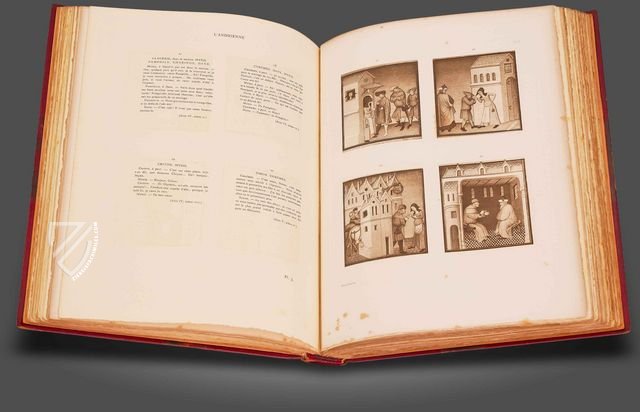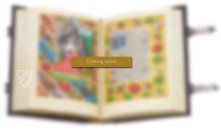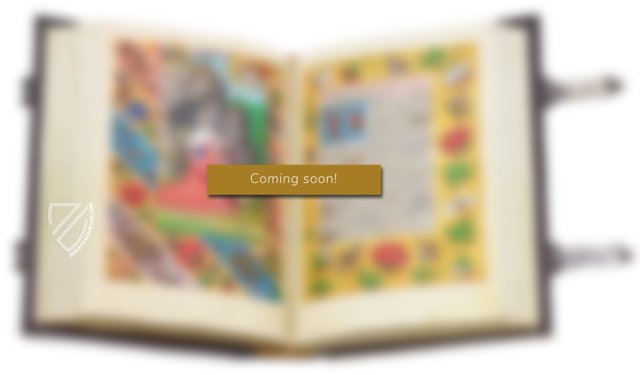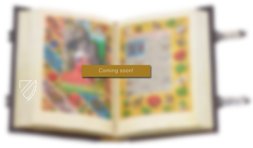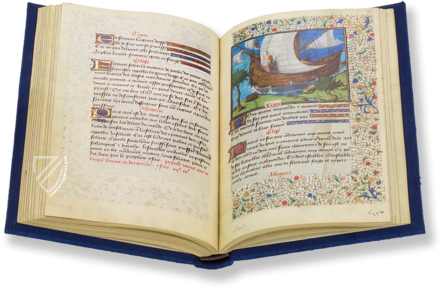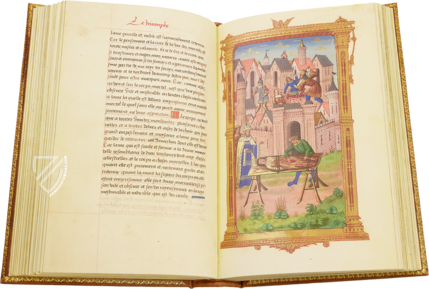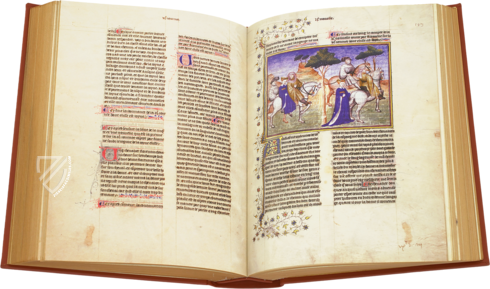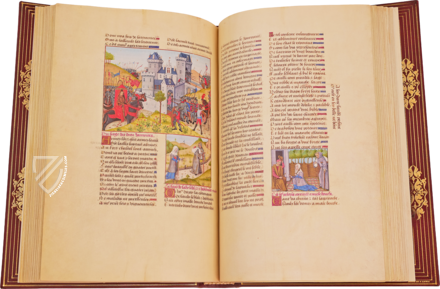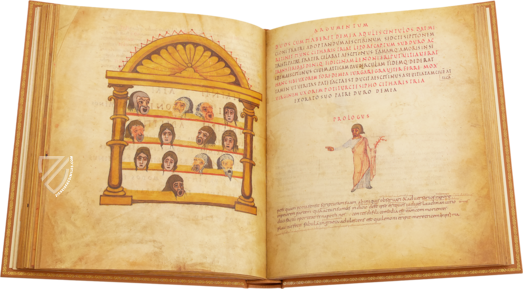Terence's Comedies
(under 1,000€)
Publius Terentius Afer, known as Terence in English, was a playwright during the Roman Republic whose comedies were first performed ca. 170-160 BC. They went on to be regarded as models of pure Latin and were used for teaching from the Middle Ages until the early modern period. Of over 600 surviving manuscript witnesses for the work, about a dozen illuminated copies exist. This fine specimen from the early-15th century was created for Duke Louis de Guyenne, third son of King Charles VI of France. It has one full-page miniature created under the supervision of the Bedford Master and 132 small miniatures appearing at the beginning of each scene attributed to the Master of Luçon, the Master of the City of the Ladies, the Master of the Adelphs, and the Master of Orose.
Terence’s Comedies
It is said that the Romans conquered the Greeks in War and the Greeks conquered the Romans in peace through the superiority of their culture. Aside from art, architecture, science, and philosophy, the Romans also borrowed much of their sense of humor from the so-called Hellenes. The Roman African playwright Publius Terentius Afer (ca. 195 – ca. 159 BC) spent the end of his short life in Greece where he studied their rich literary and theatrical traditions. His works were not initially popular among contemporaries but heavily influenced the instruction of Latin from Late Antiquity to the Enlightenment with some even being imitated by William Shakespeare. This particularly fine manuscript was illuminated by some of the finest artists of the period and was commissioned as a gift for Duke Louis de Guyenne (1397–1415), the eighth of twelve children and third son born to King Charles VI of France and his wife Queen Isabeau.
A Manuscript Worthy of a Prince
This masterpiece of the French Gothic style presents all six of Terence’s plays in the following order after a short description of the playwright’s life and a preamble: Andria, Eunuchus, Heauton Tomorumenos, Adelphoe, Phormioand, and Hecyra. It is adorned by 1 full-page miniature created under the supervision of the Bedford Master as well as 132 small miniatures and countless colored initials with gold backgrounds that are attributed to four illuminators: the Master of Luçon, the Master of the City of Ladies, the Master of the Adelphes, and the Master of Orosius. After the death of Louis, the manuscript was briefly owned by the famous bibliophile Duke Jean de Berry (1340–1416) and was later owned by Marc-Pierre de Voyer de Paulmy, Comte d'Argenson (1696–1764) and his nephew Marc Antoine René de Voyer, Marquis de Paulmy and d'Argenson (1722–87) – all members of the French upper nobility.
From Lowly Slave to Popular Playwright
Although the year of his birth is contested, Terence is believed to have been born a slave in or near Carthage because of his cognomen Afer, which suggested he was from the North African territory of the Afri people. He was supposedly sold to a Roman senator named P. Terentius Lucanus, who had the boy educated and freed him after becoming impressed with his abilities. Terence then became a member of the Scipionic Circle, a group of intellectuals devoted to discussing Greek culture, literature, and philosophy who were patronized by Scipio Aemilianus (185–129 BC), the Roman general who brought about the final defeat and destruction of Carthage, thus ending the Punic Wars. At the age of 25, Terence departed for Greece, from whence he would never return and is believed to have either died of disease in Greece or in a shipwreck on his return journey. The purpose of the trip was to collect materials for his plays and Terence managed to write six of his own before his early and unexplained death.
Enduring Popularity
Terrence’s comedies enjoyed were popular centuries later for Latin instruction thanks to the relatively simple, entertaining, and conversational Latin he used in combination with dynamic plots. The earliest commentary was written by Aelius Donatus in the 4th century and 650 Terence manuscripts have survived from the Early Middle Ages. Copies continued to be produced by hand until the first printed edition was published in Strasbourg in 1470. Terence was extoled by figures ranging from Dante Alighieri and Giovanni Boccaccio to Martin Luther and John Adams, President of the United States, the latter of whom wrote to his son, future President John Quincy Adams, “Terence is remarkable, for good morals, good taste, and good Latin...His language has simplicity and an elegance that make him proper to be accurately studied as a model.”
Codicology
- Alternative Titles
- Terenz: Komödien
Le Térence des Ducs
Publius Terencius Afer: Comoediae - Size / Format
- 474 pages / 33.7 × 24.0 cm
- Origin
- France
- Date
- 15th century
- Epochs
- Style
- Genre
- Illustrations
- 1 full-page miniature; 132 smaller miniatures
- Content
- Andria (The woman of Andros)
Eunuchus (The Eunuch)
Heauton Timorumenos (The Self-Tormentor)
Adelphoe (The Brothers)
Phormio (The Phormion)
Hecyra (The Mother-in-law) - Artist / School
- Bedford Master
Master of Luçon
Maître de la Cité des Dames
Master of Adelphes
Maître d'Orose
#1 Le Térence des Ducs
Language: French
The commentary was included in a separate part of the facsimile volume.
(under 1,000€)
- Treatises / Secular Books
- Apocalypses / Beatus
- Astronomy / Astrology
- Bestiaries
- Bibles / Gospels
- Chronicles / History / Law
- Geography / Maps
- Saints' Lives
- Islam / Oriental
- Judaism / Hebrew
- Single Leaf Collections
- Leonardo da Vinci
- Literature / Poetry
- Liturgical Manuscripts
- Medicine / Botany / Alchemy
- Music
- Mythology / Prophecies
- Psalters
- Other Religious Books
- Games / Hunting
- Private Devotion Books
- Other Genres
- Afghanistan
- Armenia
- Austria
- Belgium
- Belize
- Bosnia and Herzegovina
- China
- Colombia
- Costa Rica
- Croatia
- Cyprus
- Czech Republic
- Denmark
- Egypt
- El Salvador
- Ethiopia
- France
- Germany
- Greece
- Guatemala
- Honduras
- Hungary
- India
- Iran
- Iraq
- Israel
- Italy
- Japan
- Jordan
- Kazakhstan
- Kyrgyzstan
- Lebanon
- Liechtenstein
- Luxembourg
- Mexico
- Morocco
- Netherlands
- Palestine
- Panama
- Peru
- Poland
- Portugal
- Romania
- Russia
- Serbia
- Spain
- Sri Lanka
- Sweden
- Switzerland
- Syria
- Tajikistan
- Turkey
- Turkmenistan
- Ukraine
- United Kingdom
- United States
- Uzbekistan
- Vatican City
- A. Oosthoek, van Holkema & Warendorf
- Aboca Museum
- Ajuntament de Valencia
- Akademie Verlag
- Akademische Druck- u. Verlagsanstalt (ADEVA)
- Aldo Ausilio Editore - Bottega d’Erasmo
- Alecto Historical Editions
- Alkuin Verlag
- Almqvist & Wiksell
- Amilcare Pizzi
- Andreas & Andreas Verlagsbuchhandlung
- Archa 90
- Archiv Verlag
- Archivi Edizioni
- Arnold Verlag
- ARS
- Ars Magna
- ArtCodex
- AyN Ediciones
- Azimuth Editions
- Badenia Verlag
- Bärenreiter-Verlag
- Belser Verlag
- Belser Verlag / WK Wertkontor
- Benziger Verlag
- Bernardinum Wydawnictwo
- BiblioGemma
- Biblioteca Apostolica Vaticana (Vaticanstadt, Vaticanstadt)
- Bibliotheca Palatina Faksimile Verlag
- Bibliotheca Rara
- Boydell & Brewer
- Bramante Edizioni
- Bredius Genootschap
- Brepols Publishers
- British Library
- C. Weckesser
- Caixa Catalunya
- Canesi
- CAPSA, Ars Scriptoria
- Caratzas Brothers, Publishers
- Carus Verlag
- Casamassima Libri
- Centrum Cartographie Verlag GmbH
- Chavane Verlag
- Christian Brandstätter Verlag
- Circulo Cientifico
- Club Bibliófilo Versol
- Club du Livre
- CM Editores
- Collegium Graphicum
- Collezione Apocrifa Da Vinci
- Comissão Nacional para as Comemorações dos Descobrimentos Portugueses
- Coron Verlag
- Corvina
- CTHS
- D. S. Brewer
- Damon
- De Agostini/UTET
- De Nederlandsche Boekhandel
- De Schutter
- Deuschle & Stemmle
- Deutscher Verlag für Kunstwissenschaft
- DIAMM
- Droz
- E. Schreiber Graphische Kunstanstalten
- Ediciones Boreal
- Ediciones Grial
- Ediclube
- Edições Inapa
- Edilan
- Editalia
- Edition Deuschle
- Edition Georg Popp
- Edition Leipzig
- Edition Libri Illustri
- Editiones Reales Sitios S. L.
- Éditions de l'Oiseau Lyre
- Editions Medicina Rara
- Editorial Casariego
- Editorial Mintzoa
- Editrice Antenore
- Editrice Velar
- Edizioni Edison
- Egeria, S.L.
- Eikon Editores
- Electa
- Emery Walker Limited
- Enciclopèdia Catalana
- Eos-Verlag
- Ephesus Publishing
- Ernst Battenberg
- Eugrammia Press
- Extraordinary Editions
- Fackelverlag
- Facsimila Art & Edition
- Facsimile Editions Ltd.
- Facsimilia Art & Edition Ebert KG
- Faksimile Verlag
- Feuermann Verlag
- Folger Shakespeare Library
- Franco Cosimo Panini Editore
- Friedrich Wittig Verlag
- Fundación Hullera Vasco-Leonesa
- G. Braziller
- Gabriele Mazzotta Editore
- Gebr. Mann Verlag
- Gesellschaft für graphische Industrie
- Getty Research Institute
- Giovanni Domenico de Rossi
- Giunti Editore
- Graffiti
- Grafica European Center of Fine Arts
- Guido Pressler
- Guillermo Blazquez
- Gustav Kiepenheuer
- H. N. Abrams
- Harrassowitz
- Harvard University Press
- Helikon
- Hendrickson Publishers
- Henning Oppermann
- Herder Verlag
- Hes & De Graaf Publishers
- Hoepli
- Holbein-Verlag
- Houghton Library
- Hugo Schmidt Verlag
- Idion Verlag
- Il Bulino, edizioni d'arte
- ILte
- Imago
- Insel Verlag
- Insel-Verlag Anton Kippenberger
- Instituto de Estudios Altoaragoneses
- Instituto Nacional de Antropología e Historia
- Introligatornia Budnik Jerzy
- Istituto dell'Enciclopedia Italiana - Treccani
- Istituto Ellenico di Studi Bizantini e Postbizantini
- Istituto Geografico De Agostini
- Istituto Poligrafico e Zecca dello Stato
- Italarte Art Establishments
- Jan Thorbecke Verlag
- Johnson Reprint Corporation
- Josef Stocker
- Josef Stocker-Schmid
- Jugoslavija
- Karl W. Hiersemann
- Kasper Straube
- Kaydeda Ediciones
- Kindler Verlag / Coron Verlag
- Kodansha International Ltd.
- Konrad Kölbl Verlag
- Kurt Wolff Verlag
- La Liberia dello Stato
- La Linea Editrice
- La Meta Editore
- Lambert Schneider
- Landeskreditbank Baden-Württemberg
- Leo S. Olschki
- Les Incunables
- Liber Artis
- Library of Congress
- Libreria Musicale Italiana
- Lichtdruck
- Lito Immagine Editore
- Lumen Artis
- Lund Humphries
- M. Moleiro Editor
- Maison des Sciences de l'homme et de la société de Poitiers
- Manuscriptum
- Martinus Nijhoff
- Maruzen-Yushodo Co. Ltd.
- MASA
- Massada Publishers
- McGraw-Hill
- Metropolitan Museum of Art
- Militos
- Millennium Liber
- Müller & Schindler
- Nahar - Stavit
- Nahar and Steimatzky
- National Library of Wales
- Neri Pozza
- Nova Charta
- Oceanum Verlag
- Odeon
- Orbis Mediaevalis
- Orbis Pictus
- Österreichische Staatsdruckerei
- Oxford University Press
- Pageant Books
- Parzellers Buchverlag
- Patrimonio Ediciones
- Pattloch Verlag
- PIAF
- Pieper Verlag
- Plon-Nourrit et cie
- Poligrafiche Bolis
- Presses Universitaires de Strasbourg
- Prestel Verlag
- Princeton University Press
- Prisma Verlag
- Priuli & Verlucca, editori
- Pro Sport Verlag
- Propyläen Verlag
- Pytheas Books
- Quaternio Verlag Luzern
- Reales Sitios
- Recht-Verlag
- Reichert Verlag
- Reichsdruckerei
- Reprint Verlag
- Riehn & Reusch
- Roberto Vattori Editore
- Rosenkilde and Bagger
- Roxburghe Club
- Salerno Editrice
- Saltellus Press
- Sandoz
- Sarajevo Svjetlost
- Schöck ArtPrint Kft.
- Schulsinger Brothers
- Scolar Press
- Scrinium
- Scripta Maneant
- Scriptorium
- Shazar
- Siloé, arte y bibliofilia
- SISMEL - Edizioni del Galluzzo
- Sociedad Mexicana de Antropología
- Société des Bibliophiles & Iconophiles de Belgique
- Soncin Publishing
- Sorli Ediciones
- Stainer and Bell
- Studer
- Styria Verlag
- Sumptibus Pragopress
- Szegedi Tudomànyegyetem
- Taberna Libraria
- Tarshish Books
- Taschen
- Tempus Libri
- Testimonio Compañía Editorial
- Thames and Hudson
- The Clear Vue Publishing Partnership Limited
- The Facsimile Codex
- The Folio Society
- The Marquess of Normanby
- The Richard III and Yorkist History Trust
- Tip.Le.Co
- TouchArt
- TREC Publishing House
- TRI Publishing Co.
- Trident Editore
- Tuliba Collection
- Typis Regiae Officinae Polygraphicae
- Union Verlag Berlin
- Universidad de Granada
- University of California Press
- University of Chicago Press
- Urs Graf
- Vallecchi
- Van Wijnen
- VCH, Acta Humaniora
- VDI Verlag
- VEB Deutscher Verlag für Musik
- Verlag Anton Pustet / Andreas Verlag
- Verlag Bibliophile Drucke Josef Stocker
- Verlag der Münchner Drucke
- Verlag für Regionalgeschichte
- Verlag Styria
- Vicent Garcia Editores
- W. Turnowski Ltd.
- W. Turnowsky
- Waanders Printers
- Wiener Mechitharisten-Congregation (Wien, Österreich)
- Wissenschaftliche Buchgesellschaft
- Wissenschaftliche Verlagsgesellschaft
- Wydawnictwo Dolnoslaskie
- Xuntanza Editorial
- Zakład Narodowy
- Zollikofer AG

